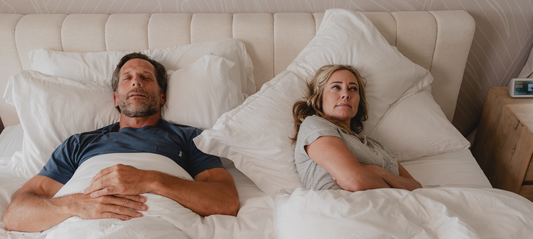If you’ve felt drowsiness while driving, you’re familiar with the jolt of fear that comes from losing awareness and control at the wheel. You fall into a zombie-like trance, your body hijacking your mental and physical function. Your shoulders slump, your eyes blur, and your lids droop or close. You might even fall asleep at the wheel!
You may try to push away the sleepiness, but willpower simply can’t overcome your body’s shutdown mode. Your drowsiness might be the consequence of too little sleep or too many hours on the road. It could also be the result of untreated sleep apnea.
What Is Drowsy Driving?
Drowsy driving is the catch-all term for operating a motor vehicle while sleepy or fatigued. Drowsiness while driving is primarily caused by sleep loss and fragmentation, which impairs your ability to focus, coordinate movement, make decisions, quickly react to your surroundings, and stay awake. In fact, according to a 2013 report by the CDC, individuals who reported sleeping fewer than six hours per night were more likely to fall asleep at the wheel.
Meanwhile, skipping out on sleep – even for one night – exacerbates the dangerous effects of sleepiness while driving. Being awake for 18 or more hours equates to having a blood alcohol (BAC) content of 0.05%, while being awake for 24 or more hours equates to a 0.10% BAC. That’s far above the federal legal limit of 0.08% BAC!
Plus, if you’ve already had a drink or more before getting on the road, lack of sleep can exacerbate the sedating effects of alcohol. You know the severe implications of driving while intoxicated; driving while sleepy can be just as harmful.
When Do Most Drowsy Driving Accidents Occur?
The “when” is an important distinction of drowsy driving accidents, as time of day is the most consistent factor associated with driver fatigue. Driver drowsiness increases significantly at night, peaking in the window between late evening and dawn. Drowsy driving accidents, therefore, occur most often after midnight, with a smaller peak at midafternoon. (A similar pattern exists for commercial drivers.)
The risk of accidents due to sleepiness also varies by age. For example, the crash risk of young drivers (ages 25 and under) and adults (ages 26 - 45) increases at night. The crash risk of older adults (ages 45 - 65) decreases at night but peaks at 7 a.m.; and during midafternoon, crash risk increases for drivers ages 65 and older.
How Common Are Sleep-Related Accidents?
Sleepiness significantly increases the risk of accidents, injuries, and fatalities on the road. In fact, drowsy driving is a factor in as many as 25% of fatal car crashes per year in the US; and it is the root cause of 10 - 30% of all vehicle crashes.
In comparison to other types of vehicle crashes, drowsy-driving crashes …
- most often involve a single person: the driver
- most often result in the vehicle going off the road
- can contribute to rear-end and head-on crashes
- occur at higher speeds and on major roadways and highways, which have higher speed limits
- have higher morbidity and mortality rates, due to the driver’s delayed reaction time and the car’s higher speeds
- do not typically show evidence of corrective driving, like skid marks or brake lights, because the driver is less alert and responsive
It’s important to note that drivers can fall asleep at the wheel in urban areas, congested highways, during the day, and with others in the car. However, a sleepy driver is more likely to crash — and the accident’s consequences are likely to be more severe — if they’re alone and driving at night on a roadway with higher speed limits.
Why Am I Falling Asleep at the Wheel?
You are more likely to experience drowsiness while driving if …
- You are a young driver, particularly a young male driver, under the age 30.
- You get insufficient sleep (fewer than six hours) on a regular basis.
- You are a commercial driver who operates vehicles such as trucks, buses, and tractor trailers.
- You work night, rotating, overtime, and/or on-call shifts.
- You use medications or substances, including alcohol, that make you fatigued or sleepy.
- You have an untreated sleep disorder, such as sleep apnea.
Can Sleep Apnea Cause Car Accidents?
Sleep apnea is associated with daytime sleepiness and fatigue; and untreated sleep apnea is linked to an increased risk of car accidents. In fact, it is estimated that every year in the US, about 800,000 drivers are involved in car collisions related to OSA.
While the severity of a person’s OSA is not a reliable predictor of car collision risk, people with more severe OSA may experience more frequent bouts of drowsiness or sleepiness. They are also involved in more frequent crashes than those with mild OSA.
Sleepiness is not the only cause of accidents, and OSA is not the only cause for sleepiness. That said, driving with untreated OSA puts you at greater risk for daytime drowsiness — and for fatigue-related car accidents.
Can You Drive If You Have Sleep Apnea?
Commercial drivers need to treat their moderate or severe sleep apnea to maintain their Commercial Driver’s License. On the other hand, there is no federal regulation that restricts or prevents the general population from driving if they have OSA.
If you’re concerned about your daytime sleepiness, particularly while driving, consider additional indicators of sleep apnea that you may experience: chronic and loud snoring, choking or gasping while sleeping, or preexisting health conditions such as obesity, diabetes, and hypertension. OSA is treatable, which means that daytime sleepiness — and your risk for car accidents — can be reduced, or even prevented, with proper diagnosis and treatment.
If you think you have OSA, try a Lofta home sleep test. You’ll be connected to a doctor who will analyze your sleep results and give you a clinical diagnosis. If you’re diagnosed with OSA, you will also receive a prescription and treatment recommendations.
Learn everything you need to know about at home sleep testing in our comprehensive guide.
How to Be More Alert When Driving
The best prevention method for drowsy driving is to get adequate sleep before you get behind the wheel. Here are other tips for staying alert while driving:
- Make a driving game plan, including scheduled rest breaks, before you hit the road.
- Drive with someone else so you can switch off driving and keep each other more alert.
- Take a nap, preferably several hours before the drive to maximize its effect on your performance.
- Avoid driving in the late-night hours, especially between midnight and dawn.
- Avoid drinking alcohol or taking any sedative medications!
If you feel sleepy while driving, take immediate steps to intervene. Switch driving with someone else; or if you’re driving alone, stop driving. Then call for a ride or find a place to sleep. Recognizing the signs of sleepiness while driving, particularly sudden and uncontrollable fatigue, can reduce your risk of accident compared to someone who denies their fatigue and stays behind the wheel.
Ways to Prevent Accidents Due to Lack of Sleep
The causes for drowsy driving are the same for drowsy anything: untreated sleep disorders, lack of sleep, an irregular sleep schedule, intoxication, and certain medications. For safer driving in the long run, consider your sleep health and possible underlying causes for your fatigue. Understanding the impact of lifestyle factors on your sleep helps you take measures to avoid drowsiness before you get in the car.
Do you get sufficient, uninterrupted sleep each night?
Most adults need at least seven hours of uninterrupted sleep each day; adolescents need at least 8 hours.
Do you have a consistent sleep schedule?
Working the night shift or long hours can throw off the time and amount that you sleep, which can make you more sleepy when you’re awake — and of course, when you’re driving. Your work schedule or lifestyle needs may be out of your control, but try to create an environment that improves the quality and quantity of your sleep.
Do you take medications or substances that make you tired?
Even one drink of alcohol worsens the effects of sleepiness. Sedative medications or substances can also severely interfere with your safe driving abilities.
Do you have symptoms of sleep apnea?
The disrupted airflow caused by sleep apnea leads to one or more of these telltale symptoms: loud snoring, gasping or choking while sleeping, dry mouth, morning headaches, irritability, and of course, daytime sleepiness.
Though sleep apnea occurs during your sleep, its effects can be experienced throughout the day, even while you drive. If you suspect you have OSA, take a home sleep test. Diagnosing and treating OSA can keep you awake at the wheel and increase your ability to safely navigate the open road.










































